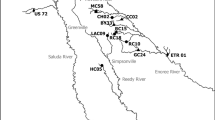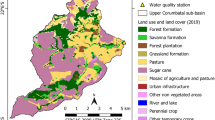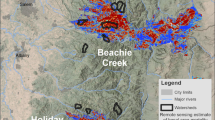Abstract
Large wood (LW) is critical to the structure and function of streams and forests are the main LW source to stream channels. To assess the influence of forest cover changes at different spatial scales on in-stream LW quantity, we selected eighteen catchments (2nd–4th order) in Southeastern Brazil with forests at different levels of alterations. In each catchment we quantified the pattern of forest cover (% cover and relative catchment position), the physical characteristics of catchments (elevation and slope), the characteristics of channels (wetted channel width and depth), the abundance and volume of in-stream LW, and the frequency of LW pools. We used simple and multiple linear regression to assess the response of LW variables to landscape and stream reach variables. Most of the LW was relatively small; 72 % had a diameter <20 cm, and 66 % had a length <5 m. Although percent forest cover at reach scale had substantial support to explain LW variables, the best predictors of LW variables were forest cover at broader scales (LW abundance and LW pool frequency were best predicted by forest at intermediate distance at the catchment scale and LW volume was best predicted by forest cover at the drainage network scale), suggesting that downstream transport is an important process in addition to local processes in our study area. These findings have important management implications because although low forested reaches receive less LW from local forests (or no LW in the case of deforested stream reaches), they are receiving LW from upstream forested reaches. However, the material is generally small, unstable and likely to be easily flushed. This suggests that not only should riparian forest conservation encompass the full drainage network, but forests should also be allowed to regenerate to later successional stages to provide larger, higher quality LW for natural structuring of streams.




Similar content being viewed by others
References
Allan JD, Castillo MM (2007) Stream ecology: structure and function of running waters. Springer, New York
Allmendinger NE, Pizzuto JE, Potter NJ, Johnson TE, Hession WC (2005) The influence of riparian vegetation on stream width, eastern Pennsylvania, USA. Geol Soc Am Bull 117:229–243
Andrus CW, Long BA, Froehlich HA (1988) Woody debris and its contribution to pool formation in a coastal stream 50 years after logging. Can J Fish Aquat Sci 45:2080–2086
Arnold TW (2010) Uninformative parameters and model selection using Akaike’s information criterion. J Wildl Manag 74(6):1175–1178
Bélanger L, Grenier M (2002) Agriculture intensification and forest fragmentation in the St. Lawrence valley, Québec, Canada. Landscape Ecol 17:495–507
Benda LE, Bigelow P, Worsley TM (2002) Recruitment of wood to streams in old-growth and second-growth redwood forests, northern California, U.S.A. Can J For Res 32:1460–1477
Berg N, Carlson A, Azuma D (1998) Function and dynamics of woody debris in stream reaches in the central Sierra Nevada, California. Can J Fish Aquat Sci 55:1807–1820
Bilby RE, Bisson PA (1998) Function and distribution of large woody debris. In: Naiman RJ, Bilby RE (eds) River ecology and management: lessons from the Pacific Coastal Ecoregion. Springer, New York, pp 324–346
Bilby RE, Ward JW (1989) Changes in characteristics and function of woody debris with increasing size of streams in western Washington. Trans Am Fish Soc 118:368–378
Bilby RE, Ward JW (1991) Characteristics and function of large woody debris in streams draining old-growth, clear-cut, and second-growth forests in southwestern Washington. Can J Fish Aquat Sci 48:2499–2508
Bisson PA, Montgomery DR (1996) Valley segments, stream reaches, and channel units. In: Hauer R, Lamberti GA (eds) Methods in stream ecology. Academic Press, San Diego, pp 23–52
Bisson PA, Bilby RE, Bryant MD, Dolloff CA, Grette GB, House RA, Murphy ML, Koski KV, Sedell JR (1987) Large woody debris in forested streams in the Pacific Northwest: past, present, and future. In: Salo EO, Cundy TW (eds) Streamside management: forestry and fisheries interactions. Institute of Forest Resources, Seattle, pp 143–190
Brasil (1965) Lei no. 4.771 de 15/09/1965. Código Florestal
Brasil (2012) Medida Provisória no 571 de 25/05/2012
Burnham KP, Anderson DR (2002) Model selection and multimodel inference: a practical information-theoretic approach. Springer, New York
Ceapla (2010) Atlas Ambiental da bacia do rio Corumbataí. Centro de Análise e Planejamento Ambiental. Instituto de Geociências e Ciências Exatas, Rio Claro, São Paulo. http://ns.rc.unesp.br/igce/ceapla/atlas/. Accessed Sept 2011
Christofoletti A (1981) Geomorfologia fluvial. Edgard Blucher, São Paulo
DAEE (2012) Departamento de Águas e Energia Elétrica. Banco de dados fluviométricos do Estado de São Paulo. Estação 4D-023. Available from http://www.sigrh.sp.gov.br/cgibin/bdhm.exe/flu?qwe=qwe (Accessed August 2012)
Dahlström N, Nilsson C (2004) Influence of woody debris on channel structure in old growth and managed forest streams in Central Sweden. Environ Manage 33:376–384
Ferraz SFB, Vettorazzi CA, Theobald DM (2009) Using indicators of deforestation and land-use dynamics to support conservation strategies: a case study of central Rondônia, Brazil. For Ecol Manage 257:1586–1595
Fitzpatrick FA, Waite IR, D’Arconte PJ, Meador MR, Maupin MA, Gurtz ME (1998) Revised methods for characterizing stream habitat in the National Water-Quality Assessment Program: U.S. Geological Survey Water-Resources Investigations Report 98-4052
Flores L, Larrañaga A, Díez J, Elosegi A (2011) Experimental wood addition in streams: effects on organic matter storage and breakdown. Fresh Biol 56:2156–2167
Forman RTT (1995) Land mosaics: the ecology of landscapes and regions. Cambridge University Press, Cambridge
Franklin JF, Forman TT (1987) Creating landscape patterns by forest cutting: ecological consequences and principles. Landscape Ecol 1:5–18
Griscom HP, Griscom BW, Ashton MS (2009) Forest regeneration from pasture in the dry tropics of Panama: effects of cattle, exotic grass, and forested riparia. Rest Ecol 17:117–126
Gurnell A, Piegay H, Swanson F, Gregory S (2002) Large wood and fluvial processes. Fresh Biol 47:601–619
Harmon ME, Franklin JF, Swanson FJ, Sollins P, Gregory SV, Lattin JD, Anderson NH, Cline SP, Aumen NG, Sedell JR, Lienkaemper GW, Cromack KJr, Cummins KW (1986) Ecology of coarse woody debris in temperate ecosystems. Adv Ecol Res 15:133–302
Hassan MA, Hogan DL, Bird SA, May CL, Gomi T, Campbell D (2005) Spatial and temporal dynamics of wood in headwater streams or the Pacific Northwest. J Am Water Resour Assoc 41:219–899
Hawkins CP, Kershner JL, Bisson PA, Bryant MD, Decker LM, Gregory SV, Mccullough DA, Overton CK, Reeves GH, Steedman RJ, Young MK (1993) A hierarchical approach to classifying stream habitats features. Fisheries 18:3–12
IGC (1979) Instituto Geográfico e Cartográfico do Estado de São Paulo
Jensen JR (2000) Remote sensing of the environment: an earth resource perspective. Prentice Hall, Upper Saddle River
Keeton WS, Kraft CE, Warren DR (2007) Mature and old-growth riparian forests: structure, dynamics, and effects on Adirondack stream habitats. Ecol Appl 17:852–868
Keller EA, Swanson FJ (1979) Effects of large organic material on channel form and fluvial processes. Earth Surf Proc 4:361–380
Koffler NF (1993) Uso das terras da bacia do Rio Corumbataí em 1990. Geografia 18:135–150
Kreutzweiser DP, Good KP, Sutton TM (2005) Large woody debris characteristics and contributions to pool formation in forest streams of the Boreal Shield. Can J Fish Aquat Sci 35:1213–1223
Lima RAF, Zanforlin M, Gandolfi S, Rodrigues RR (2008) Repeated disturbances and canopy disturbance regime in a tropical semi-deciduous forest. J Trop Ecol 24:85–93
Lorenzi H (2008) Árvores brasileiras: manual de identificação e cultivo de plantas arbóreas nativas do Brasil. Instituto Plantarum de Estudos da Flora, Nova Odessa
Lowe-McConnell RH (1964) The fishes of the Rupununi savanna district of Britsh Guiana, Pt 1. Grouping of fish species and effects of the seasonal cycles on the fish. J Linn Soc Zool 45:103–144
Maser C, Sedell JR (1994) From the forest to the sea, the ecology of wood in streams, rivers, estuaries, and oceans. St Lucie Press, Florida
May CL (2002) Debris flows through different forest age classes in the central Oregon Coast Range. J Am Water Resour Assoc 38:1097–1113
May CL, Gresswell RE (2003) Large wood recruitment and redistribution in headwater streams in the southern Oregon Coast Range, USA. Can J For Res 33:1352–1362
May CL, Gresswell RE (2004) Spatial and temporal patterns of debris-flow deposition in the Oregon Coast Range, USA. Geomorphology 57:135–149
Mcdade MH, Swanson FJ, McKee WA, Franklin JF, Van Sickle J (1990) Source distances for coarse woody debris entering small streams in western Oregon and Washington. Can J For Res 20:326–330
McHenry ML, Shott E, Conrad RH, Grette GB (1998) Changes in the quantity and characteristics of large woody debris in streams of the Olympic Peninsula, Washington, U.S.A. (1982–1993). Can J Fish Aquat Sci 55:1395–1407
Merten E, Finlay J, Johnson L, Newman R, Stefan H, Vondracek B (2010) Factors influencing wood mobilization in streams. Water Resour Res 46:1–13
Murphy ML, Koski KV (1989) Input and depletion of woody debris in Alaska streams and implications for streamside management. N Am J Fish Manage 9:427–436
Nagasaka A, Nakamura F (1999) The influences of land use changes on hydrology and riparian environment in a northern Japanese landscape. Landscape Ecol 14:543–556
Naiman RJ, Bilby RE, Bisson PA (2000) Riparian ecology and management in the Pacific Coastal Rain Forest. Bioscience 5:996–1011
Paula FR (2010) Diversidade das comunidades de peixes de riachos em função da estrutura da paisagem em microbacias da bacia do rio Corumbataí, SP. Dissertação, Universidade Estadual Paulista “Julio de Mesquita Filho”
Paula FR, Ferraz SFB, Gerhard P, Vettorazzi CA, Ferreira A (2011) Large woody debris input and its influence on channel structure in agricultural lands of Southeast Brazil. Environ Manage 48:750–763
Power ME (2003) Life cycles, limiting factors, and behavioral ecology of four Loricariid catfishes in a Panamanian stream. In: Arratia G, Kapoor BG, Chardon M, Diogo R (eds) Catfishes. Science Publishers, Enfield, pp 581–600
Quinn GP, Keough MJ (2002) Experimental design and data analysis for biologists. Cambridge University Press, Cambridge
R Development Core Team (2011) R: a language and environment for statistical computing. R Foundation for Statistical Computing, Vienna, Austria. ISBN 3-900051-07-0. Available from http://www.R-project.org (Accessed January 2011)
Ribeiro MC, Metzger JP, Martensen AC, Ponzoni FJ, Hirota MM (2009) The Brazilian Atlantic Forest: how much is left, and how is the remaining forest distributed? Implications for conservation. Biol Conserv 142:1141–1153
Robison EG, Beschta RL (1990) Identifying trees in riparian areas that can provide coarse woody debris to streams. For Sci 36:790–801
Rodrigues RR (1999) A vegetação de Piracicaba e municípios de entorno. Circular Técnica do IPEF 189:1–18
Rosenfeld JS, Huato L (2003) Relationship between large woody debris characteristics and pool formation in small coastal British Columbia streams. N Am J Fish Manage 23:928–938
Schreuder HT, Gregoire TG, Wood GB (1993) Sampling methods for multiresource forest inventory. Wiley, New York
Sedell JR, Reeves GH, Hauer FR, Stanford JA, Hawkins CP (1990) Role of refugia in recovery from disturbances: modern fragmented and disconnected river systems. Environ Manage 14:711–724
Swanson FJ (2003) Wood in rivers: a landscape perspective. In: Gregory SV, Boyer KL, Gurnell AM (eds) The ecology and management of wood in world rivers. American Fisheries Society Symposium 37, Bethesda, MD, pp 299-313
Swanson FJ, Lienkaemper GW, Sedell JR (1976) History, physical effects and management implications of large organic debris in western Oregon streams. Portland, OR: U.S. Department of Agriculture, Forest Service, Pacific Northwest Forest and Range Experiment Station, General Technical Report PNW-GTR-056
Sweeney BW, Bott TL, Jackson JK, Kaplan LA, Newbold JD, Standley LJ, Hession WC, Horwitz RJ (2004) Riparian deforestation, stream narrowing, and loss of stream ecosystem services. Proc Nat Acad Sci 101:14132–14137
USGS (2012a) United States Geological Survey. Water-resources data for the United States, site 14362250. Available from http://waterdata.usgs.gov/nwis/nwisman/?site_no=14362250&agency_cd=USGS (Accessed August 2012)
USGS (2012b) United States Geological Survey. Water-resources data for the United States, site 14353500. Available from http://waterdata.usgs.gov/nwis/nwisman/?site_no=14353500&agency_cd=USGS (Accessed August 2012)
Valente ROA, Vettorazzi CA (2003) Mapeamento de uso e cobertura do solo da Bacia do Rio Corumbataí, SP. Circular Técnica do IPEF 186:1–9
Van Sickle J, Gregory SV (1990) Modeling inputs of large woody debris to streams from falling trees. Can J For Res 20:1593–1601
Van Sickle J, Johnson CB (2008) Parametric distance weighting of landscape influence on streams. Landscape Ecol 23:427–438
Victor MAM, Cavalli AC, Guillaumon JR, Filho RS (2005) Cem anos de devastação: Revisitada 30 anos depois. Brasília, Ministério do Meio Ambiente
Warren DR, Kraft CE (2008) Dynamics of large wood in an eastern US mountain stream. Forest Ecol Manage 256:808–814
Warren DR, Kraft CE, Keeton WS, Nunery JS, Likens GE (2009) Dynamics of wood recruitment in streams of the northeastern US. For Ecol Manage 258:804–813
Wright JP, Flecker AS (2004) Deforesting the riverscape: the effects of wood on fish diversity in a Venezuelan piedmont stream. Biol Conserv 120:439–447
Acknowledgments
This project was supported by FAPESP (Proc. 06/00797-2; 06/04723-3 and 03/10505-0). We would like to thank all colleagues for help during field work and all landowners who gave us permission to work on their properties. Also, we are thankful to anonymous reviewers that contributed to improving the manuscript.
Author information
Authors and Affiliations
Corresponding author
Electronic supplementary material
Below is the link to the electronic supplementary material.
Rights and permissions
About this article
Cite this article
de Paula, F.R., Gerhard, P., Wenger, S.J. et al. Influence of forest cover on in-stream large wood in an agricultural landscape of southeastern Brazil: a multi-scale analysis. Landscape Ecol 28, 13–27 (2013). https://doi.org/10.1007/s10980-012-9809-1
Received:
Accepted:
Published:
Issue Date:
DOI: https://doi.org/10.1007/s10980-012-9809-1




